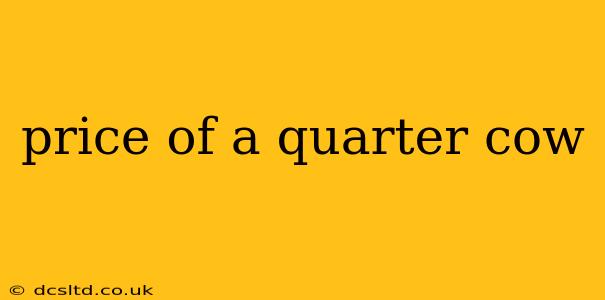Buying a quarter cow, or even a share in a larger animal, is becoming increasingly popular as more people seek access to locally sourced, high-quality meat. However, determining the exact price can be tricky. Unlike buying a pre-packaged steak at the grocery store, the cost of a quarter cow involves several factors that significantly impact the final price. This guide will break down those factors, helping you understand what to expect when purchasing your share.
What Factors Influence the Price of a Quarter Cow?
Several key factors influence the final cost of a quarter cow, making it difficult to give a single definitive price. These include:
-
Breed of Cattle: Different breeds command different prices. Popular beef breeds like Angus, Hereford, and Charolais will typically cost more than less common breeds. Angus, known for its marbling and tenderness, often commands a higher price per pound.
-
Weight of the Cow: The larger the cow, the more meat you'll receive, thus increasing the overall cost. A price is often quoted per pound of hanging weight (the weight of the carcass after slaughter and before butchering).
-
Processing Fees: After the cow is slaughtered, processing fees are incurred for butchering, packaging, and freezing the meat. These fees vary significantly depending on the butcher's location and services offered. Some butchers offer additional services like custom cuts, which can add to the cost.
-
Location: Geographical location plays a significant role. Costs of land, labor, and transportation all contribute to the final price. Rural areas may have lower costs than urban ones.
-
Method of Purchase: Are you buying directly from a farmer, a co-op, or a meat-sharing service? Each option may have different pricing models and associated fees. Direct purchase from a farmer often allows for more negotiation.
-
Seasonality: Prices can fluctuate slightly depending on the season and market demand.
How Much Does a Quarter Cow Typically Cost?
While providing an exact price is impossible without considering the factors above, you can expect to pay anywhere from $1,000 to $3,000 or more for a quarter cow. This broad range highlights the variability. The lower end might represent a smaller, less-desirable breed purchased directly from a farmer, while the higher end reflects a larger, high-quality breed processed with additional services.
What Does a Quarter Cow Typically Yield?
The amount of meat you receive from a quarter cow depends heavily on the animal's size and weight. However, a general estimate is between 100 to 200 pounds of usable meat. This translates to numerous steaks, roasts, ground beef, and other cuts, providing ample meat for a family for several months.
What About Delivery and Storage?
Delivery and storage costs are additional expenses you need to factor into your budget. Some farmers may offer delivery within a certain radius, while others might require you to pick up the meat. You'll also need sufficient freezer space to store the large quantity of meat.
Are there alternatives to buying a whole or half cow?
Yes, several alternatives exist:
-
Meat CSA (Community Supported Agriculture): These programs provide regular deliveries of meat from local farms, offering a flexible option for those wanting locally sourced products without committing to buying a share of an animal.
-
Buying in bulk from a local butcher: This allows you to purchase larger quantities of meat at a discounted price compared to buying individual cuts.
-
Joining a meat club or co-op: These groups often negotiate better prices with local farmers and butchers, passing the savings onto their members.
Conclusion
Purchasing a quarter cow can be a rewarding experience, offering access to high-quality, locally sourced meat. However, carefully researching the factors influencing the cost ensures you get a fair price and understand what you're paying for. Thoroughly compare options, ask detailed questions, and factor in all associated costs before committing to your purchase. Remember, the total cost will depend significantly on your choices regarding breed, processing, and location.
